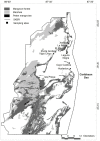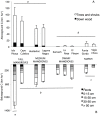Carbon stocks of tropical coastal wetlands within the karstic landscape of the Mexican Caribbean
- PMID: 23457583
- PMCID: PMC3572964
- DOI: 10.1371/journal.pone.0056569
Carbon stocks of tropical coastal wetlands within the karstic landscape of the Mexican Caribbean
Abstract
Coastal wetlands can have exceptionally large carbon (C) stocks and their protection and restoration would constitute an effective mitigation strategy to climate change. Inclusion of coastal ecosystems in mitigation strategies requires quantification of carbon stocks in order to calculate emissions or sequestration through time. In this study, we quantified the ecosystem C stocks of coastal wetlands of the Sian Ka'an Biosphere Reserve (SKBR) in the Yucatan Peninsula, Mexico. We stratified the SKBR into different vegetation types (tall, medium and dwarf mangroves, and marshes), and examined relationships of environmental variables with C stocks. At nine sites within SKBR, we quantified ecosystem C stocks through measurement of above and belowground biomass, downed wood, and soil C. Additionally, we measured nitrogen (N) and phosphorus (P) from the soil and interstitial salinity. Tall mangroves had the highest C stocks (987±338 Mg ha(-1)) followed by medium mangroves (623±41 Mg ha(-1)), dwarf mangroves (381±52 Mg ha(-1)) and marshes (177±73 Mg ha(-1)). At all sites, soil C comprised the majority of the ecosystem C stocks (78-99%). Highest C stocks were measured in soils that were relatively low in salinity, high in P and low in N∶P, suggesting that P limits C sequestration and accumulation potential. In this karstic area, coastal wetlands, especially mangroves, are important C stocks. At the landscape scale, the coastal wetlands of Sian Ka'an covering ≈172,176 ha may store 43.2 to 58.0 million Mg of C.
Conflict of interest statement
Figures




References
-
- Donato DC, Kauffman JB, Murdiyarso D, Kurnianto S, Stidham M, et al. (2011) Mangroves among the most carbon-rich forests in the tropics. Nature Geoscience 4: 293–297.
-
- Nellemann C, Corcoran E, Duarte CM, Valdes L, De Young C, et al... (2009) Blue Carbon. The role of healthy oceans in binding carbon. A rapid response assessment. United Nations Environmental Program, GRID-Arendal, Norway. 79p.
-
- IPCC (2003) Intergovernmental Panel on Climate Change (IPCC) in Good practice guidance for land use, land-use change, and Forestry. Penman J et al.., editor, Kanagawa, Japan: Institute for Global Environmental Strategies.
-
- Laffoley D d'A, Grimsditch G (2009) The management of natural coastal carbon sinks. Gland, Switzerland.
Publication types
MeSH terms
Substances
LinkOut - more resources
Full Text Sources
Other Literature Sources
Research Materials
Miscellaneous

